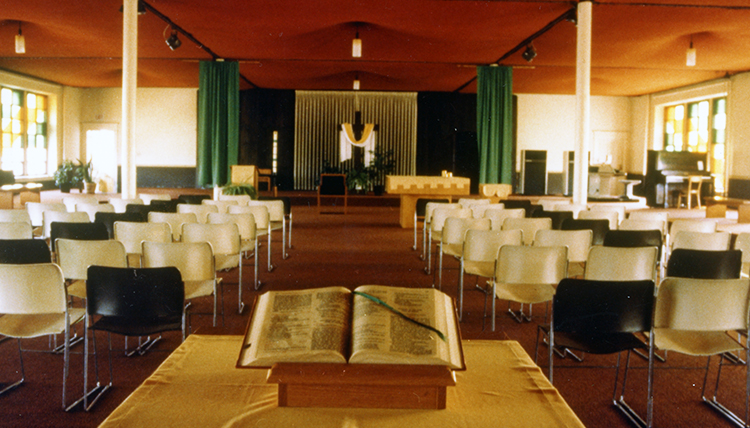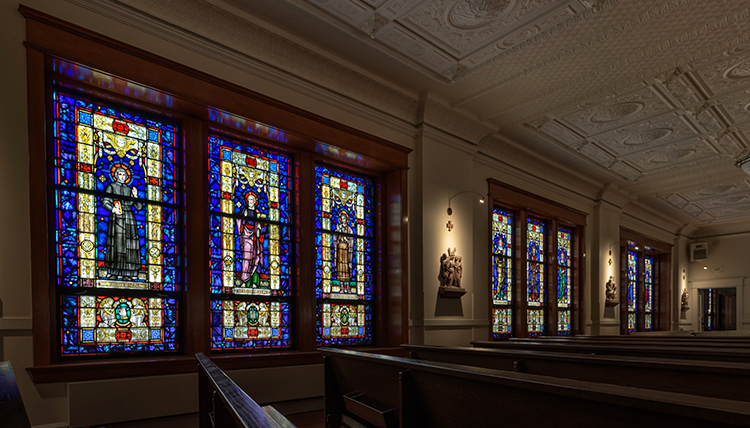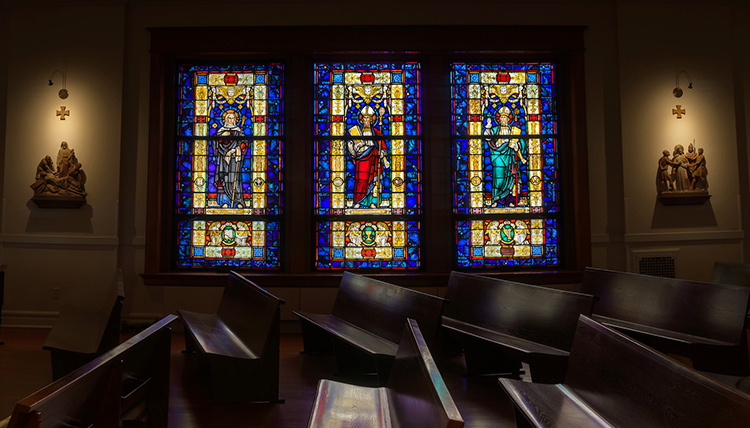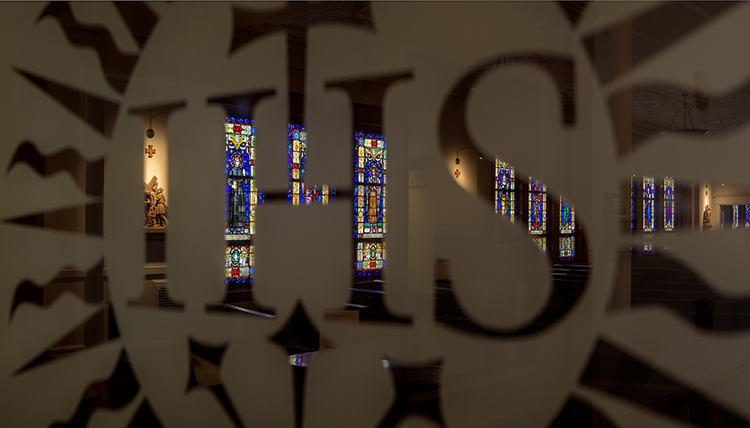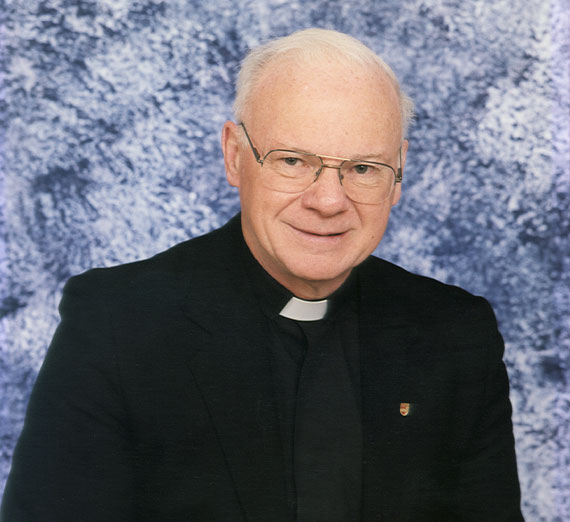Then & Now: University Chapel
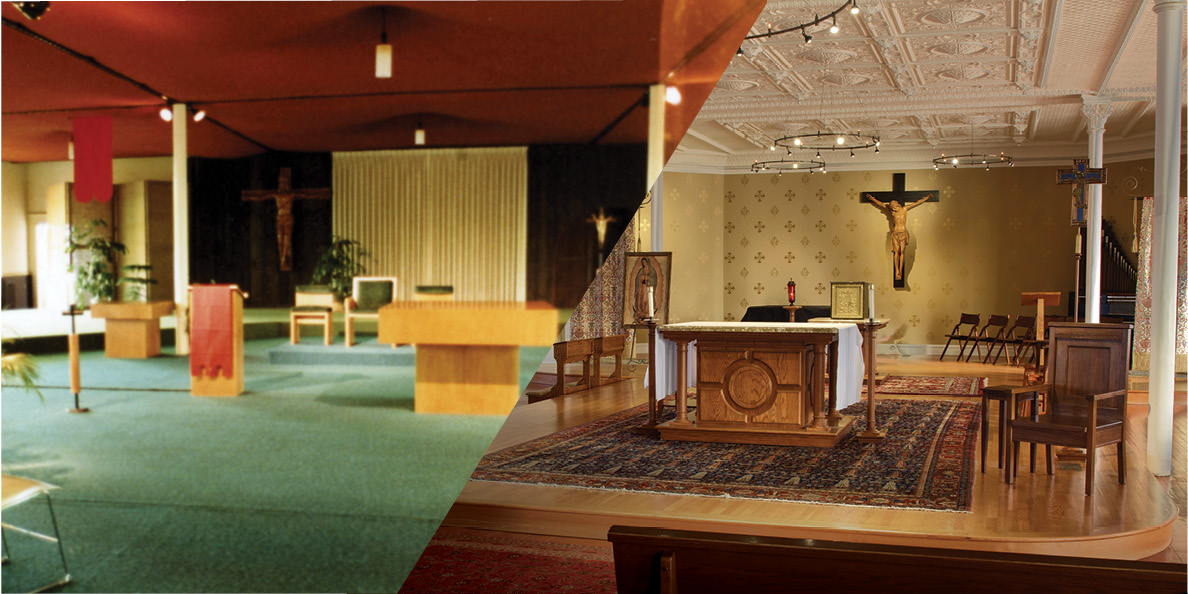
In an interesting twist of fate, Gonzaga’s first Vice President for Mission Bill Watson, S.J., wanted to be an architect but became a priest, while Mac McCandless spent eight years in a seminary to become a priest before deciding on a secular career in architecture.
This combo’s career decisions made for an impressive team with just the right credentials to mastermind the badly needed renovation of the University Chapel in 2001.
“Father Watson called me and said, ‘We’ve got to do something with the chapel,’ ” recalls McCandless, then the University’s campus architect. “He said we’ve got to recapture the soul of this place.”
McCandless, slightly stymied by the Jesuit’s response, asked what he meant. To which Fr. Watson replied, “You’re the architect.”
It was a good thing that McCandless had the religious background he did, having attended Notre Dame and acquired a sense of religious style and form. He also had done some restoration work at Notre Dame dormitory chapels and later at St. Aloysius Church.
But Watson was not without his own design sensibilities.
“It influenced what we see in the chapel today,” McCandless says.
The result of this team’s enterprise was nothing less than spectacular.
Burlap and Shag
In 1968, post-Vatican II, the state of the chapel reflected a previous restoration reflective of the current times. During the demolition, the original wood pews, altar and stations of the cross were thrown out the chapel windows via a chute and crashed to the ground three stories below. An orange burlap ceiling hung from rails above thick shag carpet; walls painted dark olive green covered the frescos. Attendees would sit on the floor or on a 10-inch riser around the room’s periphery.
When the burlap ceiling was removed in 2001, it revealed handcrafted ornate pressed tin tiles from the original chapel, which were restored. The shag carpet was removed and the original rusty-colored fir floor was sanded and masterfully refinished. A carpet runner placed down the middle aisle led to the new wooden altar, designed by McCandless. Dimmable custom circular light clusters were hung over the center aisle. When lit, the hardware disappears, giving visitors a sense of a starry night.
Despite efforts to restore the frescos and motifs painted by Jesuit Brother Joseph Carignano on the wall behind the altar in 1904 – and painted over in the 1968 post-Vatican II renovation – the artwork could not be saved. McCandless and Fr. Watson chose to adorn that wall with stenciled faux gold-leaf Gothic fleurs d’ lis and crosses in a contrasting high gloss/flat paint pattern. Custom-built stained wood pews replaced plastic chairs with thin metal frames.
Art in Stained Glass
Arguably the most compelling change was the installation of 27 leaded stained-glass windows, each commemorating a saint. They were crafted for The Most Blessed Sacrament Church in Philadelphia in 1925, which was replacing them with energy-efficient plain glass windows.
Learning of this, Fr. Watson researched and purchased the windows. But wait, the windows were only 3-by-7 feet, and the window frames in the University Chapel were 4-by-8. Watson hired a pair of Philadelphia fine artists to re-create additional leaded glasswork around the outside of the original leaded glass to create windows the right size for Gonzaga.
“The way these fine artists were able to extend the windows to perfectly match the artwork on the original pieces was nothing short of incredible,” McCandless says.
The young artists – Emily Reiss, then 24, and Sara Kratzer, then 25 – loaded 28 stained glass windows on a truck and hauled them across the country, then installed 27 of them in the chapel.
So, what happened to the 28th window, which depicts St. Michael the Archangel? It now graces the Kennedy Apartments chapel named for the saint.
Chapel History
The original chapel was built in 1904, part of the east expansion of the Administration Building. It represented traditional Catholic structure with pendant gas lighting, clear windows with lace curtains framed by heavy brocade drapes, and pews with particularly narrow seating so patrons would sit up and pay attention.
Just 12 years after the major renovation in 1967-68, Fred Hayes- Adams, then assistant director of Campus Ministry, said “the folksy décor” had outworn its welcome. Walls were painted off-white, orange and green colored-glass windows were installed and cast-off metal and plastic chairs from the COG were installed.
“The 2001-02 restoration attempted to balance the best of the original chapel with the need to adapt to current liturgical practices,” McCandless says. “Achieving that required a skilled team of diverse tradespeople, fabricators and artisans who pooled their talents and efforts to create this unique space, which was special to many of them.”
In the end, Gonzaga’s Chief Strategy Officer Chuck Murphy, a freshman in 1969, says it is the community that has made this chapel a special place.
“I recall that the daily services were well attended by students who enjoyed the singing with guitar and other instrumentation. Weekend and holiday services were usually standing-room- only affairs because many Spokane alums attended, bringing their families, as well. There was a great sense of community with this mix of current and former students, and our Jesuit Community members did a great job of connecting to both constituencies, making it truly a celebration,” Murphy says.
McCandless adds, “When I stand here today and see how folks feel inside this place, I know it is special.”
The last major renovation of the University Chapel was in 2001, made possible with gifts from Mary and Jack McCann and Emma and Mike Patterson (’69). Many of the 27 leaded stained-glass window panels, purchased from a church in Philadelphia, were dedicated to loved ones by other generous donors. Stations of the cross were recycled from a Franciscan retreat center in Portland, Oregon, and are lit to show the detail in the wood carvings.
- Arts & Culture
- Faith & Mission
- Student Life
- Division of Mission Integration
- Gonzaga Magazine

